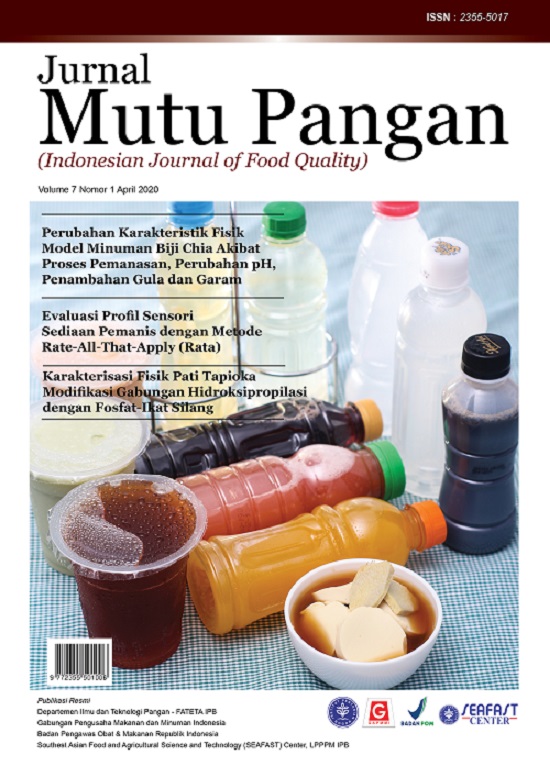Profil Sensori Sediaan Pemanis dengan Metode Rate-All-That-Apply (RATA)
Abstract
Sweetener is food additive consisting of natural sweetener and artificial sweetener which give sweet sensation to food products. Table-top sweeteners are sought due to its advantages in comparison to sugar, which is giving off sweet sensation in food with no or low calorie. This is proven useful for people who suffer from illnesses, such as diabetes mellitus, obesity, and sensitive tooth. This need should be supported by development of table-top sweeteners to satisfy consumer preferences. Rate-All-That-Apply (RATA) is a consumer based test developed from Check-All-That-Apply (CATA). The objective of this research is to study sensory profiles of various table-top sweeteners based on diabetic and non-diabetic consumer and its intensity, as well as identifying attributes which determines consumer preference. There were six table-top sweeteners used in this study with three group of panelists based on their medical history. The research result revealed that sweetener A was identic to the attribute cooling, sweet aftertaste, sweet, body thickness, licorice, and mouth drying. Sweetener C and F were identic to the attribute metallic aftertaste, bitter aftertaste, bitter, and metallic. Diabetics give the most hedonic score above the average value to Sweetener A, B, and D. Non-diabetics with a heredity of diabetes give the most hedonic score above the average value to Sweetener B. Non-diabetics without a heredity of diabetes give the most hedonic score above the average value to Sweetener D and E. Generally, consumer could not identify attributes which determines their preference, however they could define unwanted attributes in table-top sweeteners, which are bitter, bitter aftertaste, metallic, metallic aftertaste, and mouth drying.
Downloads
References
[AMI] Applied Market Information. 2001. Market share of non-caloric sweeteners by segments. AMI Business Consulting Analysis.
Ares G, Bruzzone F, Vidal L, Cadena RS, Gimenez A, Pineau B, Hunter DC, Paisley AG, Jaeger SR. 2014. Evaluation of a rating-based variant check-all- that-apply questions: Rate-All-That-Apply (RATA). Food Quality and Preferences. 36(2014): 87-95. DOI: 10.1016/j.foodqual.2014.03.006.
Ares G, Deliza R, Barreiro C, Gimenez A, Gambaro A. 2009. Comparison of two sensory profiling techniques based on consumer perception. Food Quality and Preference. 21(2010): 417-426. DOI: 10.1016/j.foodqual.2009.10.006.
Ares G, Varela P, Rado G, Gimenez A. 2011. Are consumer profiling techniques equivalent for some product categories? The case of orange-flavoured powdered drinks. International Journal of Food Science and Technology. 46(1):1600-1608. DOI: 10.1111/j.1365-2621.2011.02657.x
[BPOM] Badan Pengawas Obat dan Makanan. 2014. Peraturan Kepala Badan Pengawas Obat dan Makanan Republik IndonesiaNomor 4 Tahun 2014 tentang Batas Maksimum Penggunaan Bahan Tambahan Pangan Pemanis. Jakarta (ID): BPOM.
Deis, RC. 2006. Customizing sweetness profiles. Food Product Design.15(11):1-5.
Meilgaard MC, Civile GV, Carr BT. 2016. Sensory evaluation technique. CRC Press, New York, USA.
Menteri Kesehatan Republik Indonesia. 2012. Peraturan Menteri Kesehatan Republik Indonesia No: 033 Tahun 2012 tentang Bahan Tambahan Pangan. Jakarta (ID): Menteri Kesehatan.
Lawless HT. Heymann H. 2010. Sensory Evaluation of Food: Principles and Practices. New York (US): Springer.
Sediva A, Panovska Z, Pokorny J. 2006. Sensory profiles of sweeteners in aqueous solutions. Czech Journal of Food Science. 24(6): 283-287.
Wansink B. 2003. Response to “Measuring consumer responses to food product” sensory test that predict consumer acceptance. Food Quality and Preference, 14: 23-26.
Wasalathanthri S, Hettiarachchi P, Prathapan S. 2014. Sweet taste sensitivity in pre- diabetics, diabetics, and normoglycemic controls: a comparative cross sectional study. BMC Endocrine Disorders. 14(1).

















